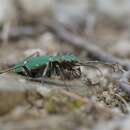en
names in breadcrumbs


Cicindela, commonly known as common tiger beetles,[1] are generally brightly colored and metallic beetles, often with some sort of patterning of ivory or cream-colored markings. They are most abundant and diverse in habitats very often near bodies of water with sandy or occasionally clay soils; they can be found along rivers, sea and lake shores, sand dunes, around dry lakebeds, on clay banks, or woodland paths.
The word "Cicindela" comes from the Latin word "cicindela", meaning "glowworm". This comes from the fact that members of the genus Cicindela are metallic and sometimes flashing.[1]
The genus Cicindela is (in its broadest historical sense) the largest genus of tiger beetles, and they occur worldwide. The status of the genus is constantly in a state of flux, as various authorities on different continents have vastly different opinions about which (if any) of the dozens of subgenera traditionally recognized within the genus are deserving of being accorded status as independent genera. Moreover, this is one of the few insect taxa in which the rank of subspecies has traditionally been used repeatedly, and essentially no two classifications consistently treat the various members of the genus as to which are species and which are subspecies.
Treated as a single genus, and even with a fairly conservative estimate of species, there are over 850[2] (or even up to 2,300) species in the group[3] (thus being almost equal to the subtribe Cicindelina (W.Horn, 1908), with several thousand published names applied, collectively. Currently most of the subgenera below are not settled, being considered genera of their own by some, and subgenera of the genus Cicindela by others. The genus is divided into the following subgenera:
For a list of species, see List of Cicindela species. The subgenus Cicindela (Cicindela), or Cicindela sensu stricto contains the following species:
Cicindela depressula ssp depressula
Cicindela, commonly known as common tiger beetles, are generally brightly colored and metallic beetles, often with some sort of patterning of ivory or cream-colored markings. They are most abundant and diverse in habitats very often near bodies of water with sandy or occasionally clay soils; they can be found along rivers, sea and lake shores, sand dunes, around dry lakebeds, on clay banks, or woodland paths.